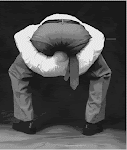A little more than two weeks ago, I wrote my first entry about Netflix. At that point, I had 145 movies in my queue and 579 rated movies, both of which seem like a lot.
Uh, not so much. These days I'm up to 193 movies in the queue and 769 rated movies. This would seem like showing off if it wasn't actually saying that I clearly spend way too much time watching movies (769 movies, assuming I've only watched them all once, which I definitely haven't, translates to more than 64 straight days).
Anyhow, as last time, I thought I would review a few of the movies that I've been working my way through.
#1 Shoot the Piano Player (1964, Francois Truffaut) tells the story of Charlie, a once famous concert pianist (played by 5'3" Charles Aznavour, looking amazingly like a water rat) who, driven to depression after his wife's suicide, has been reduced to playing in a parisian bar under a pseudonym.
Now, the movie's description says that "when his brothers get in trouble with gangsters, Charlie inadvertently gets dragged into the chaos and is forced to rejoin the family he once fled."
And that's the part that grabbed me. Sadly, however, the movie wasn't really like that, choosing to spend most of it's 84 minute running time focusing on Charlie's past and his budding romance with a waitress in the bar, who fortunately doesn't look at all like a water rat.
But once I got over my disappointment, I found Shoot the Piano Player pretty enjoyable. It switches back a forth a bit between comedic and noir touches. But, aside from the end, where Charlie's son gets kidnapped by mobsters who are looking for his brother and Charlie is forced to go after them, the movie is mostly a portrait of a damaged guy who, rather than dealing with his problems, has escaped into a level of existence low enough he hope he can hide from them.
But, as the movie proves, eventually it catches up with you.
My rating: 3.5 stars out of 5.
#2 The Verdict (1982, Sidney Lumet) is the story of Frank Gavlin, a down on his luck alcoholic lawyer played brilliantly by Paul Newman. Reduced from his once promising career to stalking funeral homes and giving his card to the bereaved, Gavlin is on his way out.
Then a friend of his (played by Jack Warden) shows up, offering him an easy case: a woman was given the wrong anesthetic and ended up with brain damage. Gavlin sees an easy payday, but while investigating the case, something in him suddenly snaps, and he decides he wants to try and win it in court rather than settle.
Standing in his way is an attorney dubbed the "Prince of Darkness" (played with charming ruthlessness by one of my favorite actors, James Mason), who will stop at nothing to beat Gavlin, and an antagonistic judge.
Now if you're thinking this story sounds a bit cliche, well, you're right. But the movie doesn't play that way. Newman, Lumet and legendary screenwriter David Mamet conspire to make the plot seem to spring from the peculiarities of the characters. And while the story and character seem grim, Newman's charm makes its way through his portrayal of the damaged Gavlin.
The character's final summation is one of the most famous in the history of the movies.
My rating: 3.5 out of 5 stars.
#3 Rififi (1955, Jules Dassin) is a wonderful French crime movie. Directed by the expatriate Dassin, an American who had been forced to flee the US due to HUAC, Rififi tells the story of a group of thieves who plan and execute an elaborate jewel heist.
The key character is Tony le Stephanois, a serious-as-a-heart attack ex-con riddled with tuberculosis played Jean Servais with tired, lethal authority (Servais himself was an alcoholic).
In a sequence that would inspire countless heist films to follow, the burglars cut through a hole in the ceiling above the jewelry store, crack the safe and escape with the jewels. The sequence is done without music or dialogue and takes up a quarter of the movie's 115 minute running time. And it's fantastic. It was realistic enough to get the movie banned in Finland and Mexico, where it was thought that similar burglaries would be attempted because of it.
But as exciting as the burglary is, the movie is still only half over. Due to carelessness by one of the team, a ruthless nightclub owner with a longstanding feud with le Stephanois finds out about the team, and he goes about tracking them down. Eventually, the son of one of the men is kidnapped. This springs le Stephanois, coughing and brutal, into action, and he begins to hunt the men down, tracking them to a house in the country.
Rififi is the perfect example of a well executed crime/noir film. Though the protagonists are thieves and killers, they're loyal to each other and to a code of conduct. As hardbitten as le Stephanois is, in earlier scenes he's gentle with the young boy who eventually gets kidnapped, making his desperate search for him something we can identify with.
So yeah, it's a great movie. And a bonus, to you folks who want to see it, is that someone's posted a high quality version of it on YouTube. Embedding has been disabled, but it's available at this link:
Part 2 is here, to give you an idea how the titles have been formatted.
Needless to say, Rififi gets a 5 out of 5.
So that's that. I didn't get a chance to review Buster Keaton's Seven Chances here. But if you're interested, it was good, but not great. Say a 3 out of 5.













